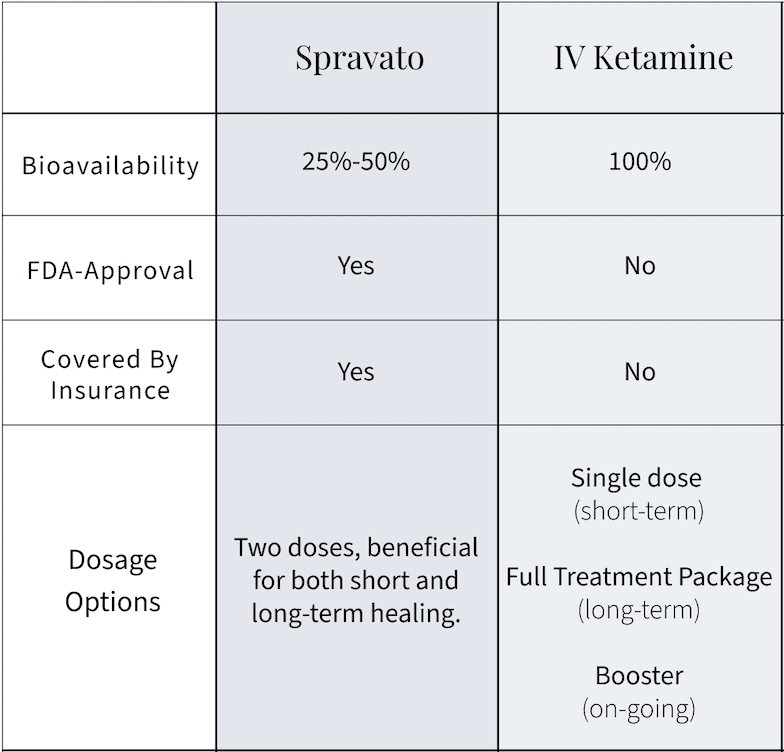How does IV ketamine therapy compare to nasal ketamine spray?
Over the past decade the mental health treatment landscape has expanded beyond pharmacology and psychotherapy. Today, patients with treatment-resistant depression, anxiety, and PTSD have more access to groundbreaking interventions, like ketamine infusion therapy (or intravenous ketamine) and esketamine nasal spray.
While both IV ketamine and intranasal esketamine share similarities in their mechanisms of action— and are effective in reducing depressive symptoms—the two treatments are not completely synonymous.
In this article we’ll compare and contrast theses groundbreaking options to help you better determine which treatment is right for you.
Understanding Ketamine Therapy
Before we dive into the debate around IV ketamine therapy vs. esketamine, let’s first review the basics of ketamine therapy.
Ketamine was first approved as an anesthetic in 1970. But throughout the succeeding decades ketamine’s significant (and rapid) antidepressant effects came to light across numerous clinical studies.
Ketamine works to combat the effects of chronic stress and treatment resistant depression by stimulating neuroplasticity in the brain. Low-dose ketamine treatments promote the production of neurotransmitters and proteins that are involved with regulating how regions of the brain send and receive chemical messages.
Boosted by neuroplasticity, the brain forms new neural connections to support mood regulation and emotional processing.
Today, mental health professionals can administer ketamine for depression in a range of modes:
- ketamine infusion therapy (IV therapy)
- intramuscular injections
- tablets
- Esketamine nasal spray
IV Ketamine Therapy
IV ketamine therapy involves the administration of ketamine through an intravenous infusion. During a session, a healthcare provider carefully administers a controlled dose of ketamine directly into the patient’s bloodstream.
The Experience
IV Ketamine is administered in a medical office under the supervision of a certified healthcare professional. Because the ketamine is administered directly into the bloodstream, many IV ketamine patients experience dissociation during the hour-long treatment sessions.
Dissociation can take a variety of forms: some patients feel as though they are floating in a dream-like state and others feel as though they have stepped outside of their bodies to view themselves from an entirely new vantage point.
Because of the strong dissociation effects of IV ketamine therapy, integration exercises are especially beneficial and patients are encouraged to set specific intentions before a session, and journal about their experience after.
Treatment timeline
While a single IV ketamine session may stimulate immediate relief from depressive symptoms, specialists recommend at least 6 infusion therapy sessions (over 3-4 weeks) to experience the full extent of its antidepressant benefits.
Considerations
Although IV ketamine therapy is becoming an increasingly mainstream treatment, it is not yet approved by the FDA for general anxiety or depressive disorder. Additionally, IV ketamine may spark temporary side effects, like dizziness, nausea, and increased blood pressure.
Esketamine Therapy:
Esketamine, often marketed under the brand name Spravato, is a newer formulation of ketamine that has been approved by the FDA for treatment resistant depression. Though this nasal spray is self-administered, it is only ever used under the direct supervision of a healthcare provider.
The experience
Spravato esketamine nasal spray is always administered in-office (never at home). After the self-administered spray, patients relax in an on-site waiting room so that medical staff can periodically check in and monitor the effects of the spray before clearing the patient to go home.
The esketamine nasal spray is less bioavailable than its infusion counterpart, with research indicating a maximum bioavailability of 48%. Because of this, the dissociative effects (though, still present) tend not to be as intense intravenous ketamine, which has a 100% bioavailability rate.
Treatment timeline
Following a full Spravato protocol involves twice-weekly treatment sessions for the first four weeks. After week 4, the number of sessions drops to once a week. Finally, at the nine-week mark, treatments reduce to bi-weekly sessions.
Considerations
Experts recommend Spravato esketamine nasal spray in conjunction with an oral anti-depressant. Though generally well tolerated, Esketamine nasal spray side effects may include dizziness, nausea, an increase in blood pressure, and post-treatment tiredness. Esketamine nasal spray is FDA-approved and covered by many carriers.
Both IV ketamine and esketamine therapy offer valuable options for individuals struggling with treatment-resistant depression. Ultimately, the choice between IV ketamine and esketamine therapy should be made in consultation with a healthcare provider.
IV ketamine therapy vs. Esketamine therapy comparison chart
